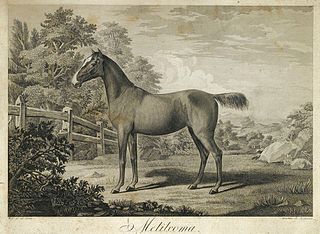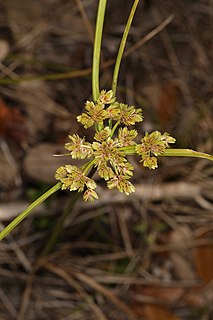
Cyperus is a large genus of about 700 species of sedges, distributed throughout all continents in both tropical and temperate regions.
Heinrich Christian Friedrich Schumacher was a Danish surgeon, botanist and professor of anatomy at the University of Copenhagen. Schumacher carried out significant research work in malacology, in other words on molluscs, and assigned systematic names to many taxa.

Cyperus polystachyos, also known as Pycreus polystachyos, and also called manyspike flatsedge in the US, or bunchy sedge, coast flatsedge, many-spiked sedge or Texas sedge in Australia, is a herbaceous species in the family Cyperaceae, widespread in tropical and subtropical areas around the world, sometimes extending its range into temperate regions.

Kyllinga is genus of flowering plants in the sedge family known commonly as spikesedges. They are native to tropical and warm temperate areas of the world, especially tropical Africa. These sedges vary in morphology, growing to heights from 2.5 centimeters to a meter and sometimes lacking rhizomes. They are closely related to Cyperus species and sometimes treated as part of a more broadly circumscribed Cyperus.

Ficinia nodosa, the knotted club-rush or knobby club-rush, is a rhizomatous perennial in the family Cyperaceae, native to South Africa, Australia, and New Zealand. Widespread in the Southern Hemisphere, Ficinia nodosa grows to between 15 and 220 cm in height. Although it grows best in sandy, salty soil, the plant grows in a wide variety of environments from coastal sand dunes to alpine regions. F. nodosa’s appearance is characterised by dense clusters of long green stems topped with small, rounded flowers often remaining throughout the year.
Rolandra is a genus of flowering plants in the Vernonieae within the daisy family.

Christen Friis Rottbøll was a Danish physician and botanist: He was a pupil of Carolus Linnaeus.
Peder Lauridsen Kylling was a 17th-century Danish botanist.

Johan Theodor Holmskiold was a Danish noble, botanist, courtier and administrator. He was noted for his scientific work with fungi and development of the Charlottenborg Botanical Garden. His career included work as director of the Danish Postal Services and the Royal Porcelain Factory.

Meno Haas aka Johann Meno Haas was a German-born copperplate engraver, miniaturist, illustrator and painter. He was the brother of George and Peter Haas (1754–1804), and father of Jean Meno Haas. Meno was the son and student of the engraver Jonas Haas (1720–1775). He also trained under Johann Georg Preisler (1757–1831) at the Academy of Copenhagen

Cyperus pygmaeus, also known as dwarf flat sedge, is a sedge of the family Cyperaceae that is native to Australia.

Cyperus surinamensis, also known as the tropical flatsedge, is a sedge of the family Cyperaceae that is native to the Americas.
Cyperus conglomeratus is a species of sedge that is native to northern Africa, the Middle East and parts of western Asia.

Cyperus corymbosus is a species of sedge that is endemic to parts of South America, Africa, the Middle East and western Asia.
Cyperus cruentus is a species of sedge that is native to parts of eastern Africa and the Arabian peninsula.
Cyperus fastigiatus is a species of sedge that is native to parts of South Africa.
Cyperus jeminicus is a species of sedge that is native to parts of Africa, the Middle East and India.
Cyperus pangorei is a species of sedge that is native to parts of Asia.

Cyperus procerus is a species of sedge that is native to parts of Africa, Asia and Australia.
Cyperus serotinus is a species of sedge that is native to parts of Europe and Asia.










